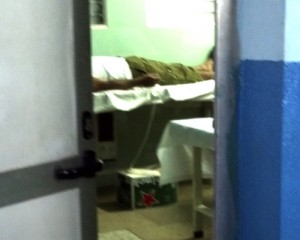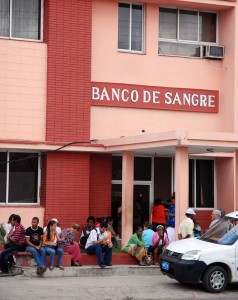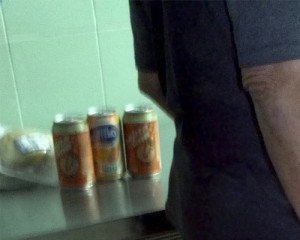 Cubanet, Pablo Gonzalez, Havana, 20 March 2015 – Each state enterprise has to deliver a quantity of blood donations each month in order to comply with the rule established by the Ministry of Public Health (MINSAP). Each clinic has to make one hundred donations per month.
Cubanet, Pablo Gonzalez, Havana, 20 March 2015 – Each state enterprise has to deliver a quantity of blood donations each month in order to comply with the rule established by the Ministry of Public Health (MINSAP). Each clinic has to make one hundred donations per month.

The pressure that MINSAP and the Committees in Defense of the Revolution (CDRs) put on the clinics makes their workers go out into the streets desperately searching for donors.
Without doing any prior testing they carry out the blood extractions with poor medical instrumentation.
Voluntary blood donation in Cuba, begun in 1962, has grown to reach and exceed the target set by the World Health Organization for one donation for each 20 inhabitants. According to the Granma newspaper, blood donations exceeded what was planned in the last two years.
Donor Yasmany Machado, 27 years of age from Sancti Spiritus in the Fomento Province, commented on this report in Granma on the web page of the daily itself:
“Since 2005 I have been a blood donor more than 20 times for the benefit of others. Now I ask myself the following question: Are donors encouraged by MINSAP and the CDRs? Is it perhaps resolved with a role for the district? Why does MINSAP not worry about the health of the donors?”
And Yasmany’s commentary continues: “Why is modest help with food not offered to those who donate blood? Saying that the blood bank is poorly supplied (she refers to the bread with ham and cheese and the soda that they give to the donors). It is insufficient most of the time what is given to the donor … When the CDR wants your help and you are due, they visit you so that you go to donate. But no one is able, not the director of health nor the coordinator responsible for the CDRs, to see how you are. Well, to donate and comply yes, but to see what the bank gives to the donor, no… Why don’t they give two pieces of bread in the blood donor’s snack? Because all the protein, most of it, you donate it at that moment… I don’t understand, I will not understand… Signed: A blood donor, totally disappointed with the country’s policy. I am not satisfied…”

Most donors, like almost all Cubans, are people who have nothing in their homes for breakfast or they eat a poor breakfast. Sadly, they donate their blood simply in order to eat the bread with ham and cheese, and the soda that they give after each donation.
This phenomenon is understandable. In stores this same bread costs a dollar sixty-five and the can of soda 50 cents. The average Cuban salary being around 20 dollars a month, there are few who can give themselves the luxury of buying bread with ham and cheese for breakfast.
Doctor Luis Enrique Perez Ulloa, chief of the National Blood Program for MINSAP, said that the Cuban blood program is multi-faceted and that in Cuba 340,000 people routinely donate blood.
But a nurse from the “Leonor Perez” clinic-hospital in Boyeros, who preferred anonymity, says:
“We have to do wonders to meet the established standard. We go out to the streets looking for donors. Any person will do to count one more. We tell the workers at the clinics that they have to donate. If they do it we give them the day off as a reward. Always looking for ways to turn them into donors or at least get them to donate once. Many are vagrants, hopeless ones from the streets who easily give their blood without much prodding because of the snack that we give them afterwards, when there is a snack, because often it is lacking.”
There are others who come because they paid them – concludes the nurse – or because they bribed them at some work center.

Not only do the clinics have to meet a monthly standard for donations. Each state enterprise also must deliver a quantity of donations per month to the local clinic. In order to comply with the standard set, the administrators search for people outside of the workplace. They bribe them with goods gotten from the workplace itself: food, money and even drink. These bought donors present themselves at the clinic posing as employees of the state entity that bribed them.
Enrique Gonzalez, a donor at the same hospital clinic, commented: “I have been a donor for many years, and I am here because my work center sent me. The doctors have told me that I have to continue doing it because if I don’t, my hemoglobin will go up. They give me the day off every time I do it, at work they give me two pounds of chicken per donation, and also I eat the snack that they give after the donation.”
A doctor of the hospital clinic who asked that his name not be revealed said:
“We do not worry much about who the donors are, where they come from or the reasons for which they donate; what is important is that the most people donate to be able to meet the established standard. It is not always met, but we do everything possible.”
There is a black market in blood. For a curettage or any kind of operation, they do not use the blood from the bank; on the contrary, they demand that the patient’s family bring a donation of blood. Donations cost about 20 dollars. And donors always appear for that money.
Voluntary and good faith donations are well-received, but in Cuba most people donate blood for money, for a piece of bread with ham for breakfast.
Translated by MLK
